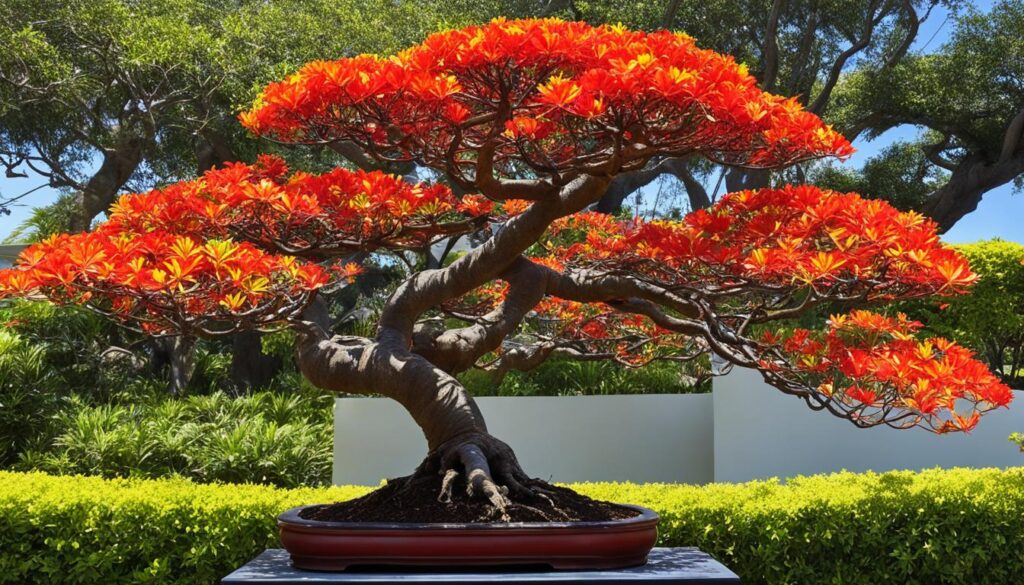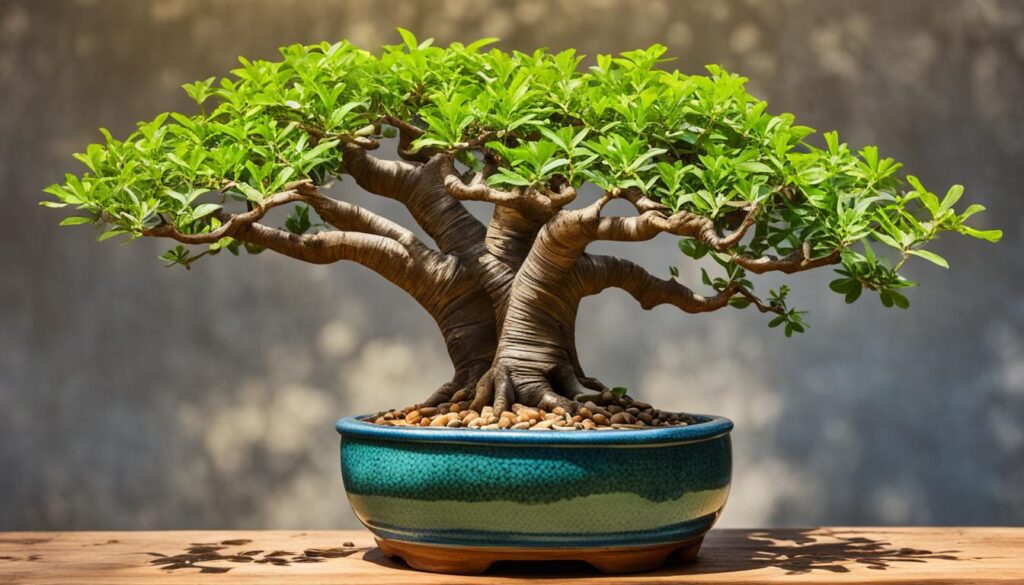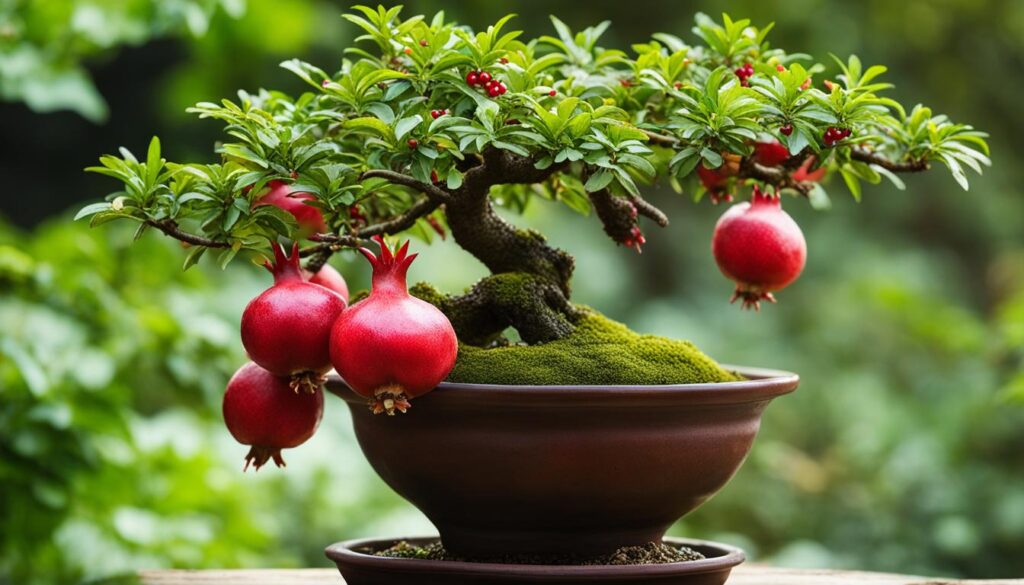Flame Tree Bonsai (Delonix regia), also known as Royal Poinciana is renowned for its stunning red flowers and lush foliage. Its vibrant colors and graceful form make it a prized addition to any bonsai collection. However, this bonsai tree requires specific care and attention to thrive.
We’ll cover everything you need to know, from understanding the distinct characteristics of the Flame Tree Bonsai to mastering the art of shaping, watering, soil and fertilization, pruning and wiring, repotting, and even propagating your own Bonsai flame tree. So Let’s dive in!
Understanding the Beautiful Flame Tree Bonsai
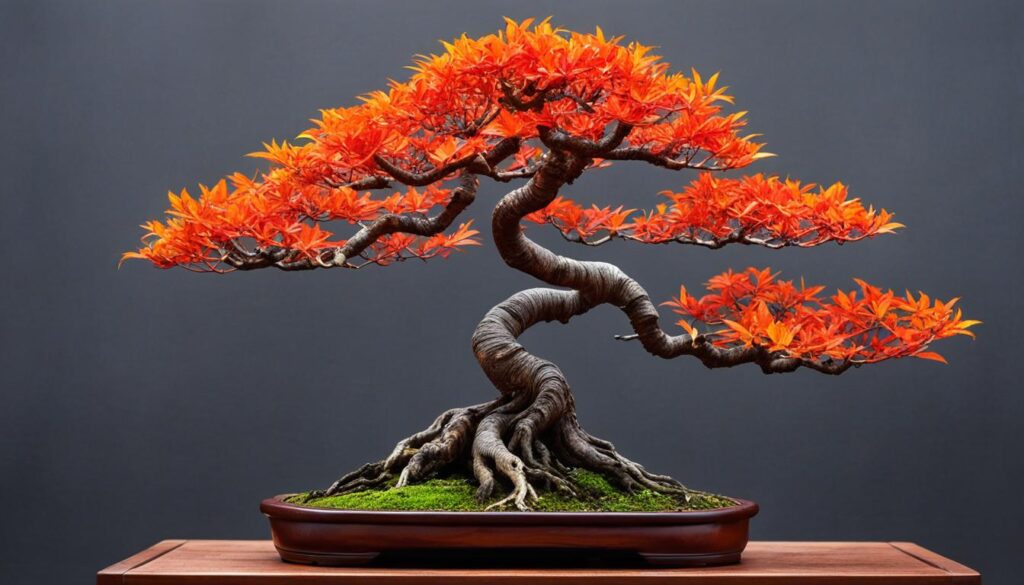
Origin and Unique Features of Delonix Regia
The Flame Tree Bonsai, known scientifically as Delonix regia, is famous for its striking beauty and distinct features. It comes from Madagascar and has attracted bonsai lovers globally with its bright flowers and fine leaves.
Delonix regia thrives in warm climates and full sunlight. It has compound leaves made up of long, feathery leaflets that give it an elegant look. The bright green foliage contrasts beautifully with the tree’s bright red and orange flowers.
The Flame Tree Bonsai is particularly admired for its bold red and orange flowers, which resemble a fiery crown. These eye-catching, trumpet-shaped blooms enhance any bonsai collection and make this tree a true standout.
Managing the Bonsai’s Rapid Growth and Size
A key challenge in caring for the Flame Tree Bonsai is handling its fast growth. This species tends to grow quickly, requiring regular upkeep to maintain its preferred size and shape.
To control the Flame Tree’s growth, pruning and training are important. Regular pruning keeps growth in check and promotes branching, resulting in a compact and attractive shape. You can also use wiring to direct the branches and achieve the desired bonsai style. By managing growth through pruning and wiring, you will create a balanced and appealing Flame Tree Bonsai.
For size management, repotting is essential. Repotting the bonsai when it outgrows its pot prevents root binding and supports healthier growth. Choosing the right pot size and soil mix helps control the tree’s size and keeps it from becoming too large or unbalanced.
Must Read: Juniper Bonsai: Complete Guide for Growing and Caring
Creatively Shaping Your Flame Tree Bonsai
Shaping a Flame Tree Bonsai is an art form that allows you to sculpt and mold the tree into your desired shape. With the right techniques and styling methods, you can transform your bonsai into a true masterpiece. In this section, we will explore the various techniques and tools you can use to shape your Flame Tree Bonsai and unleash your creativity.
Pruning:
Pruning is an essential technique in shaping your Flame Tree Bonsai. By selectively removing branches and foliage, you can control the tree’s growth and direct its energy toward specific areas. Use sharp pruning shears to make clean cuts, ensuring the health of your bonsai.
Wiring:
Wiring is another effective method for shaping your bonsai. By gently wrapping bonsai wire around branches and trunks, you can guide their growth and create elegant curves and bends. Remember to use flexible wire that won’t damage the tree, and remove the wires before they dig into the bark.
Using Guy Wires:
In certain cases, where branches are too thick or rigid, or you desire specific angles or positions, you can use guy wires. Attach the wire to the branch or trunk and anchor it with weights to gradually shape and position the tree over time. Patience is key when using this technique, as it takes time for the desired shape to be achieved.
To get started with shaping your Flame Tree Bonsai, assess the tree’s natural growth pattern and determine the style you want to achieve. Whether it’s a formal upright, slanting, or cascade style, each requires different pruning and wiring approaches. Consider the tree’s unique characteristics and strive to highlight its beauty and balance.
Remember, shaping a Flame Tree Bonsai is a continuous process that requires regular maintenance and adjustment. As the tree grows, prune and wire accordingly to maintain its desired shape and form. With dedication and practice, you can transform your Flame Tree Bonsai into a stunning work of art.
Ideal Environmental Requirements for Flame Tree Bonsai
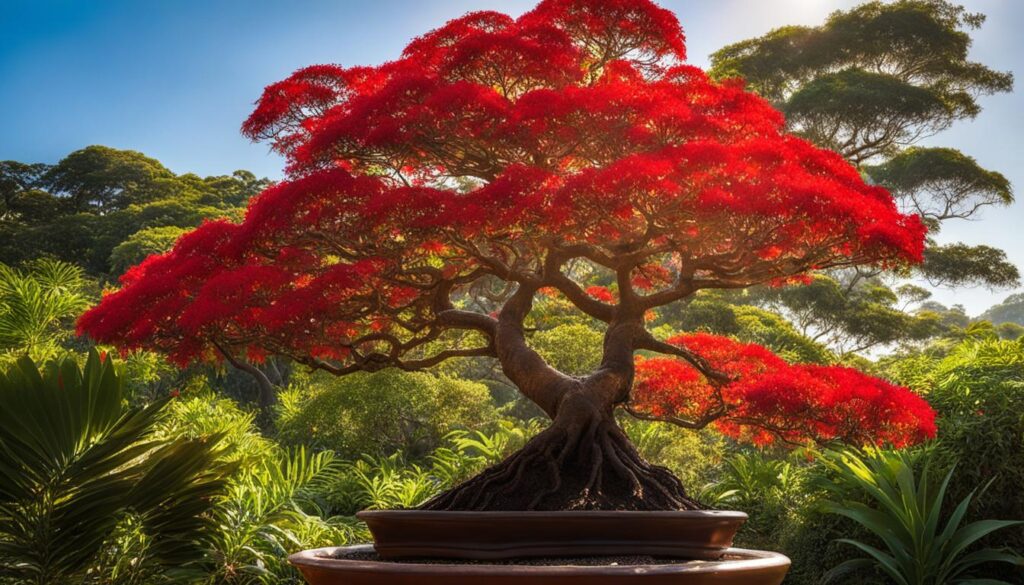
Creating the ideal environment is crucial for the health and vitality of your Flame Tree Bonsai. By understanding its environmental requirements, you can ensure that your bonsai thrives and flourishes. Here are the key factors to consider:
- Sunlight: Delonix regia bonsai thrives in bright, indirect sunlight. Place your bonsai in a location where it can receive at least 6 hours of sunlight each day.Temperature: These bonsai trees prefer warm temperatures ranging between 65°F and 85°F (18°C to 29°C). Protect your Flame Tree Bonsai from freezing temperatures and harsh winter conditions.
- Humidity: Delonix regia bonsai enjoys moderate to high humidity levels. Consider using humidity trays or misting the foliage regularly to maintain optimal humidity.
- Protection: Shield your Flame Tree Bonsai from strong winds, as they can damage the delicate foliage and branches. Provide adequate shelter or move your bonsai indoors during extreme weather conditions.
Remember, proper environmental conditions are essential for the successful growth and development of your Flame Tree Bonsai. Take the time to understand and provide the ideal environment, and your bonsai will reward you with its vibrant beauty.
| Environmental Factor | Ideal Range |
|---|---|
| Sunlight | Bright, indirect sunlight for at least 6 hours per day |
| Temperature | 65°F to 85°F (18°C to 29°C) |
| Humidity | Moderate to high humidity levels |
| Protection | Shield from strong winds and extreme weather |
Mastering the Art of Watering Your Flame Tree Bonsai
Proper watering is essential for the health and vitality of your Flame Tree Bonsai. As with any bonsai tree, understanding its unique water requirements is crucial to ensure optimal hydration without overwatering or underwatering.
Frequency: Flame Tree Bonsai should be watered regularly, especially during the growing season. Depending on the climate and environmental conditions, you may need to water your bonsai every 2-3 days or when the topsoil feels slightly dry.
Quantity: When watering your Flame Tree Bonsai, it’s important to provide enough water to moisten the entire root system thoroughly. Water until you see it reaching the drainage holes at the bottom of the pot. This ensures that the roots receive adequate hydration.
Techniques: To ensure proper watering without disturbing the fragile root structure, it is recommended to use a gentle watering can or a fine mist sprayer. This helps to avoid compaction of the soil and allows the water to evenly penetrate the root zone.
Monitoring: Keep a close eye on your Flame Tree Bonsai to prevent both underwatering and overwatering. Check the soil moisture levels by gently inserting your finger into the topsoil. If it feels dry, it’s time to water. If it feels damp, allow the soil to dry out slightly before watering again.
By mastering the art of watering your Flame Tree Bonsai and providing it with the right amount of water at the right frequency, you can ensure the overall health and vibrant growth of your bonsai tree.
Soil and Fertilization: Nourishing Your Flame Tree Bonsai

To ensure the health and vitality of your Bonsai flame tree (Delonix regia), proper soil composition and fertilization are essential. The right soil provides the necessary nutrients and drainage, while fertilizers supplement the tree’s nutritional requirements for robust growth and abundant flowering.
The ideal soil composition for Flame Tree Bonsai starts with a well-draining mixture that allows oxygen to flow to the roots. A recommended mixture is a combination of Flame tree bonsai soil, which is a well-balanced blend of organic matter, sand, and perlite, ensuring good water retention without becoming waterlogged. This special soil provides a fertile environment for the roots to develop and thrive.
When it comes to fertilization, it is important to understand the specific nutrient needs of the Flame Tree Bonsai. A balanced, slow-release organic fertilizer, such as Delonix regia fertilizer, should be applied during the growing season to provide essential nutrients gradually. Organic fertilizers not only supply the necessary macronutrients like nitrogen, phosphorus, and potassium but also offer micronutrients that are beneficial for the overall health of the tree.
It is recommended to follow the fertilizer manufacturer’s instructions for application rates and frequency. Applying fertilizer in moderation is important to prevent over-fertilization, which can damage the bonsai tree. Regularly monitoring the soil’s nutrient levels and adjusting the fertilization schedule accordingly will help to maintain the proper balance for optimal growth.
Proper soil composition and fertilization are crucial for the health and vitality of your Flame Tree Bonsai. The right soil blend, such as Flame tree bonsai soil, ensures good drainage and provides a nutrient-rich environment for your bonsai. A balanced, slow-release organic fertilizer, like Delonix regia fertilizer, supplies the necessary nutrients for robust growth and abundant flowering.
Flame Tree Bonsai Techniques for Pruning and Wiring
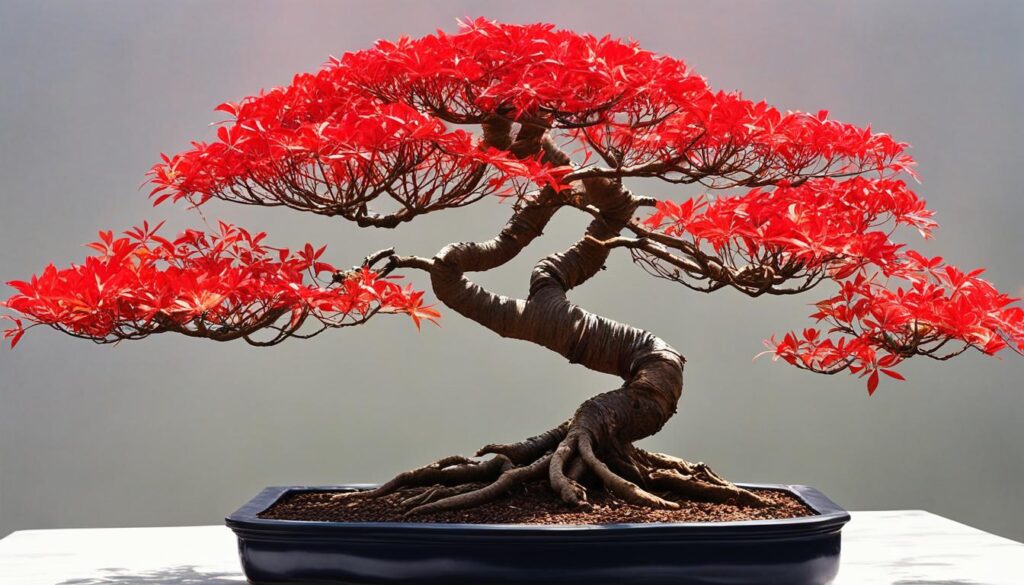
Pruning and wiring are essential techniques for shaping and training your Flame Tree Bonsai (Delonix regia). By understanding when and how to prune branches, shoots, and roots, you can maintain the desired shape of your bonsai tree while promoting healthy growth.
When pruning your Flame Tree Bonsai, it’s important to remove any dead, damaged, or overgrown branches. This not only improves the overall appearance of the tree but also allows for better airflow and sunlight penetration. Use clean and sharp pruning shears to make clean cuts, minimizing the risk of infection and promoting faster healing.
In addition to branch pruning, root pruning is also crucial in managing the growth and health of your Flame Tree Bonsai. Carefully inspect the root system and trim away any circling or tangled roots. This encourages the development of a strong and well-structured root system.
Wiring is another technique that can help shape your bonsai tree. By carefully wrapping copper or aluminum wire around branches, you can guide their growth and create beautiful bonsai tree forms. It’s important to select the appropriate thickness of wire that can support branches without causing damage. Remember to check the wire regularly and adjust it as needed to prevent it from cutting into the branches.
When using wiring, it’s crucial to follow the natural growth patterns of your Flame Tree Bonsai. Avoid excessive bending or forcing branches into unnatural angles, as this can cause harm to the tree. Always use guy wires and clips when necessary to provide additional support and maintain the desired shape.
By mastering the art of pruning and wiring, you can transform your Flame Tree Bonsai into a stunning masterpiece that showcases its unique beauty. Remember to always take a patient and careful approach, as bonsai tree training techniques require time, dedication, and a keen eye for detail.
The Significance of Proper Flame Tree Bonsai Repotting
Repotting plays a crucial role in the care and maintenance of your Flame Tree Bonsai. It provides an opportunity to refresh the soil, prune the roots, and ensure the overall health and vitality of your bonsai tree. In this section, we will discuss the significance of proper repotting for your Flame Tree Bonsai, focusing on key techniques and considerations to enhance its growth and development.
When it comes to repotting your Flame Tree Bonsai, timing is essential. Ideally, you should repot your bonsai tree every two to three years, depending on its growth rate and the health of the root system. Repotting during the spring or early summer, when the tree is actively growing, is generally recommended.
One important repotting technique for your Flame Tree Bonsai is root pruning. This process involves carefully trimming and pruning the roots to promote new growth and prevent root-bound conditions. By removing excess roots, you encourage a healthy and well-balanced root system, which is crucial for the overall well-being of your bonsai tree.
After root pruning, selecting the right pot for your Flame Tree Bonsai is crucial. The pot should be slightly larger than the root ball to allow for future growth, but not too large to hinder proper drainage. Consider using a shallow bonsai pot made of a durable material that promotes good airflow and drainage, such as clay or ceramic.
Creating a well-draining soil mix is another important aspect of proper repotting for your Flame Tree Bonsai. A mixture of organic and inorganic components, such as akadama, pumice, and lava rock, can provide the necessary drainage and nutrient retention for your bonsai tree. Additionally, adding a layer of mesh or small stones at the bottom of the pot can prevent soil erosion and ensure proper drainage.
Properly repotting your Flame Tree Bonsai not only ensures its health and vitality but also allows for future growth, development, and flourishing. By following the techniques and considerations discussed in this section, you will be able to maintain a thriving bonsai tree that brings joy and beauty to your home or garden.
Propagating Your Own Flame Tree Bonsai
In this final section, we will explore the process of propagating your own Flame Tree Bonsai. By following these steps, you can expand your bonsai collection and enjoy the satisfaction of growing your own trees.
Flame Tree Bonsai Seed Selection and Germination Strategies
To start the propagation process, select high-quality Flame Tree Bonsai seeds. Look for mature pods that have turned brown and dried on the tree. Collect the pods and gently extract the seeds. Discard any damaged or discolored seeds.
Next, prepare the seeds for germination. Soak them in warm water for 24 hours to soften the hard outer shell. This will help facilitate germination. After soaking, carefully plant the seeds in a well-draining soil mix and cover them with a thin layer of soil.
Maintaining Seedlings for Future Transplanting into Bonsai Form
As the seeds germinate and seedlings emerge, it is crucial to provide them with proper care and attention. Place the seedlings in a warm and well-lit area, ensuring they receive indirect sunlight. Keep the soil consistently moist (but not overly wet) to promote healthy growth.
Once the seedlings have developed strong root systems and several pairs of true leaves, they can be transplanted into individual pots. Use a bonsai-specific soil mix that provides excellent drainage. As the seedlings continue to grow, monitor their development closely and adjust watering and fertilization accordingly.
With patience and dedication, your Flame Tree Bonsai seedlings will mature into beautiful and unique bonsai trees. Remember to maintain consistent care and provide the ideal environment to ensure their health and longevity. Soon, you’ll have a thriving collection of Flame Tree Bonsai trees that are a testament to your passion for bonsai artistry.
Complete Rainbow Eucalyptus Bonsai Care Guide >>>
Unleash the Magic: Transform Your Christmas with This Ultimate Bonsai Tree Guide! >>>
Unbelievable Discovery: Bonsai Trees Thriving on the Most Unexpected Surfaces! >>>
Discover the 7 Jaw-Dropping Bonsai Trees That Will Transform Your Home! >>>

